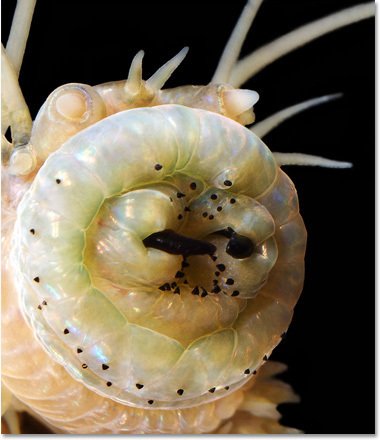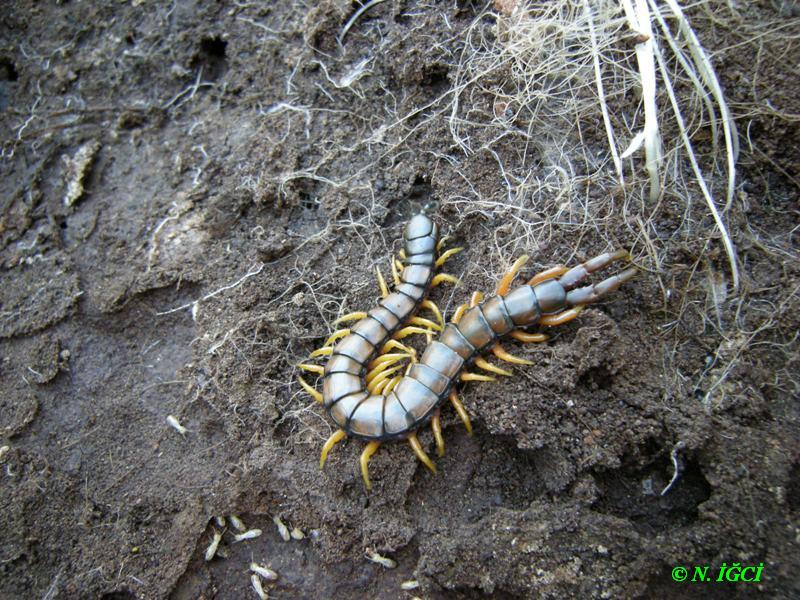جوري
Soldier Through It!
- Messages
- 27,759
- Reaction score
- 6,095
- Gender
- Female
- Religion
- Islam
[h=1]The 5 Most Nightmarish Worms on the Planet[/h] By: Andrew Munro September 03, 2012 655,261 views
Add to Favorites


You probably think you know everything you need to about worms. They're just wiggling tubes of flesh with indistinguishable asses and faces that commit suicide on sidewalks during rainstorms. All caught up. But the benign worms you're used to seeing speared on fishhooks and fried up in children's literature are only a tiny percent of all the species of worm out there. And when we say "out there," we mean "crawling free of the bowels of hell as we speak."
[h=2]#6. Bobbit Worm[/h] At over 10 feet long, bobbit worms are about the closest thing we have to the sand worm in Dune. They have toxic bristles up and down their body that can cause permanent nerve damage to anyone who touches them, and they feed by grabbing their prey with massive, strong jaws and sucking it down into the sand.
They are ambush predators that wait in shallow waters with only about a tenth of their body poking out of the sand and their mouths stretched completely open. As soon as one of their antennae detects something in the water, they lunge for it, even if it's significantly bigger than they are. Their strikes, it should be noted, are so powerful that they'll sometimes accidentally just cut fish in half while trying to grab them. So don't be fooled by the fact that, up close, it's the iridescent color of a middle school girl's Trapper Keeper.
To get a sense of how horrifying these worms are, at Newquay's Blue Reef Aquarium in the U.K., they couldn't figure out what was eating all their fish each night. They set up traps with fishing line and hooks, and each morning the lines were snapped and the hooks and bait were gone. After taking the aquarium apart, they found a massive bobbit worm in the sand that had apparently just been digesting the hooks.
Oh, and the bobbit worm, just like us, prefers warm, shallow waters. So we're probably going to have to let them have the good beaches for now.
[h=2]#5. Ragworms[/h]
 As you can see, the ragworm has an earwig's ass for a face. Those pincers right around its face hole are extraordinarily strong, too -- they can provide a nasty bite when the ragworm is threatened because the mandibles are made out of a unique substance that's both harder and lighter than most synthetic material we have. As a result, scientists have been ecstatically tearing the jaws off these worms so they can get them under a microscope and hopefully replicate it.
As you can see, the ragworm has an earwig's ass for a face. Those pincers right around its face hole are extraordinarily strong, too -- they can provide a nasty bite when the ragworm is threatened because the mandibles are made out of a unique substance that's both harder and lighter than most synthetic material we have. As a result, scientists have been ecstatically tearing the jaws off these worms so they can get them under a microscope and hopefully replicate it.
But as a non-scientist, this worm is all downsides for you. Think of all your least favorite characteristics of insects, spiders and worms, then combine them all together. It has the body of a centipede divided up into about 120 segments, each with its own set of appendages to help it swim or writhe around on land. It lives in slime-lined holes in shallow waters and spins a sticky web of mucus over the entrance like some kind of mutated snot spider.
Unlike spiders, though, who have to hang around until something's dumb enough to fly into their webs, ragworms undulate around in just the right way to create currents in the water near their trap. Any prey unlucky enough to get caught in those currents is helplessly drawn into the web, and then the ragworm just consumes the whole thing, snot web and all, because, and we can't stress this enough, it's just awful. Here's another look at its face:
Just ... wow. To the ragworm's credit, that view is more hilarious than terrifying. It looks like it just wriggled out of Jim Henson's imagination. It also has that shocked expression that says it's as surprised as anyone that it's been allowed to live this long. Oh, and did we mention they can get up to 3 feet long? So keep that in mind the next time everybody wants to go skinny dipping off the banks of some dark body of water.
[h=2]#4. Eulagisca gigantea[/h] If you're not sure what you're looking at there, let's back up. At first glance, Eulagisca gigantea doesn't seem that threatening. It is only about 8 inches long, lives far off in the waters of Antarctica and looks vaguely like it could stand in for a dustpan broom in a pinch.
Aside from that creepy, sunken head, you might almost be tempted to run your fingers through its bristles. But just be aware that there is no guarantee you would get all your fingers back. Let us show you why:
Surprise! That sunken head in the first photo is actually a whole retractable mouth with fangs. So aside from looking like a face-hugger with little blond ponytails instead of tentacles, E. gigantea also has the deflated head of a chest-burster.
Additionally, the worms have full body armor. They have tiny protective scales across their entire midsection designed to keep them safe from their main threats, which presumably are people in exosuits looking to make a name for themselves. Scientists still don't know much about their diets or how they breed, partially because they live deep in the oceans of Antarctica, and partially because why would anyone get to know something they're already certain they hate?
Add to Favorites


You probably think you know everything you need to about worms. They're just wiggling tubes of flesh with indistinguishable asses and faces that commit suicide on sidewalks during rainstorms. All caught up. But the benign worms you're used to seeing speared on fishhooks and fried up in children's literature are only a tiny percent of all the species of worm out there. And when we say "out there," we mean "crawling free of the bowels of hell as we speak."
[h=2]#6. Bobbit Worm[/h] At over 10 feet long, bobbit worms are about the closest thing we have to the sand worm in Dune. They have toxic bristles up and down their body that can cause permanent nerve damage to anyone who touches them, and they feed by grabbing their prey with massive, strong jaws and sucking it down into the sand.
They are ambush predators that wait in shallow waters with only about a tenth of their body poking out of the sand and their mouths stretched completely open. As soon as one of their antennae detects something in the water, they lunge for it, even if it's significantly bigger than they are. Their strikes, it should be noted, are so powerful that they'll sometimes accidentally just cut fish in half while trying to grab them. So don't be fooled by the fact that, up close, it's the iridescent color of a middle school girl's Trapper Keeper.
To get a sense of how horrifying these worms are, at Newquay's Blue Reef Aquarium in the U.K., they couldn't figure out what was eating all their fish each night. They set up traps with fishing line and hooks, and each morning the lines were snapped and the hooks and bait were gone. After taking the aquarium apart, they found a massive bobbit worm in the sand that had apparently just been digesting the hooks.
Oh, and the bobbit worm, just like us, prefers warm, shallow waters. So we're probably going to have to let them have the good beaches for now.
[h=2]#5. Ragworms[/h]

wiki
But as a non-scientist, this worm is all downsides for you. Think of all your least favorite characteristics of insects, spiders and worms, then combine them all together. It has the body of a centipede divided up into about 120 segments, each with its own set of appendages to help it swim or writhe around on land. It lives in slime-lined holes in shallow waters and spins a sticky web of mucus over the entrance like some kind of mutated snot spider.
Unlike spiders, though, who have to hang around until something's dumb enough to fly into their webs, ragworms undulate around in just the right way to create currents in the water near their trap. Any prey unlucky enough to get caught in those currents is helplessly drawn into the web, and then the ragworm just consumes the whole thing, snot web and all, because, and we can't stress this enough, it's just awful. Here's another look at its face:
Just ... wow. To the ragworm's credit, that view is more hilarious than terrifying. It looks like it just wriggled out of Jim Henson's imagination. It also has that shocked expression that says it's as surprised as anyone that it's been allowed to live this long. Oh, and did we mention they can get up to 3 feet long? So keep that in mind the next time everybody wants to go skinny dipping off the banks of some dark body of water.
[h=2]#4. Eulagisca gigantea[/h] If you're not sure what you're looking at there, let's back up. At first glance, Eulagisca gigantea doesn't seem that threatening. It is only about 8 inches long, lives far off in the waters of Antarctica and looks vaguely like it could stand in for a dustpan broom in a pinch.
Aside from that creepy, sunken head, you might almost be tempted to run your fingers through its bristles. But just be aware that there is no guarantee you would get all your fingers back. Let us show you why:
Surprise! That sunken head in the first photo is actually a whole retractable mouth with fangs. So aside from looking like a face-hugger with little blond ponytails instead of tentacles, E. gigantea also has the deflated head of a chest-burster.
Additionally, the worms have full body armor. They have tiny protective scales across their entire midsection designed to keep them safe from their main threats, which presumably are people in exosuits looking to make a name for themselves. Scientists still don't know much about their diets or how they breed, partially because they live deep in the oceans of Antarctica, and partially because why would anyone get to know something they're already certain they hate?









